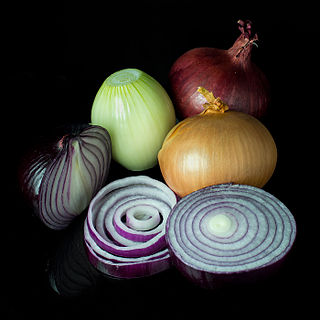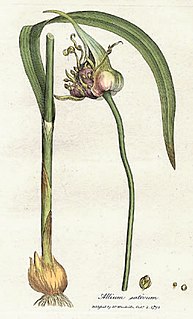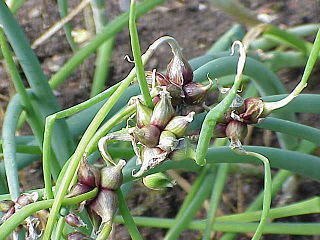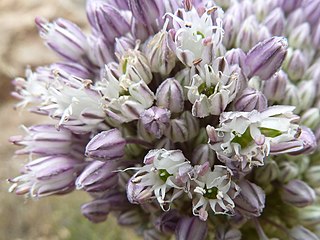In biology, the BBCH-scale for bulb vegetables describes the phenological development of bulb vegetable plants, such as onion, leek, garlic and shallot, using the BBCH-scale.

Phenology is the study of periodic plant and animal life cycle events and how these are influenced by seasonal and interannual variations in climate, as well as habitat factors. The word, coined by the Belgian botanist Charles Morren around 1849, is derived from the Greek φαίνω (phainō), "to show, to bring to light, make to appear" + λόγος (logos), amongst others "study, discourse, reasoning" and indicates that phenology has been principally concerned with the dates of first occurrence of biological events in their annual cycle. Examples include the date of emergence of leaves and flowers, the first flight of butterflies and the first appearance of migratory birds, the date of leaf colouring and fall in deciduous trees, the dates of egg-laying of birds and amphibia, or the timing of the developmental cycles of temperate-zone honey bee colonies. In the scientific literature on ecology, the term is used more generally to indicate the time frame for any seasonal biological phenomena, including the dates of last appearance.

The onion, also known as the bulb onion or common onion, is a vegetable that is the most widely cultivated species of the genus Allium. Its close relatives include the garlic, leek, chive, and Chinese onion.

The leek is a vegetable, a cultivar of Allium ampeloprasum, the broadleaf wild leek. The edible part of the plant is a bundle of leaf sheaths that is sometimes erroneously called a stem or stalk. The genus Allium also contains the onion, garlic, shallot, scallion, chive, and Chinese onion.
The phenological growth stages and BBCH-identification keys of bulb vegetables are:
| Growth stage | Code (2-digit) | Code (3-digit) | Description |
|---|---|---|---|
| 0: Germination | 00 | 000 | Dry seed,1 dormant bulb2 |
| 01 | 000 | Beginning of seed imbibition1 | |
| 03 | 003 | Seed imbibition complete1 | |
| 05 | 005 | Radicle emerged from seed.1 Roots appearing2 | |
| 07 | 007 | Cotyledon breaking through seed coat1 | |
| 09 | 009 | Emergence: cotyledon breaks through soil surface.1 Green shoot visible2 | |
| 010 | Cotyledon visible as hook1 | ||
| 011 | Hook stage: hooked cotyledon green1 | ||
| 012 | Whip stage: cotyledon has whip-like form1 | ||
| 1: Leaf development (Main shoot) | 10 | 100 | Advanced whip stage: whip begins to die off1 |
| 11 | 101 | First leaf (> 3 cm) clearly visible | |
| 12 | 102 | 2nd leaf (> 3 cm) clearly visible | |
| 13 | 103 | 3rd leaf (> 3 cm) | |
| 1 . | 10 . | Stages continuous till . . . | |
| 19 | 109 | 9 or more leaves clearly visible | |
| 4: Development of harvestable vegetative plant parts | 41 | 401 | Leaf bases begin to thicken or extend |
| 43 | 403 | 30% of the expected bulb or shaft diameter reached | |
| 45 | 405 | 50% of the expected bulb or shaft diameter reached | |
| 47 | 407 | Bolting begins; in 10% of the plants leaves bent over3 70% of the expected shaft length and diameter reached4 | |
| 48 | 408 | Leaves bent over in 50% of plants3 | |
| 49 | 409 | Leaves dead, bulb top dry; dormancy3 Growth complete; length and stem diameter typical for variety reached4 | |
| 5: Inflorescence emergence | 51 | 501 | Onion bulb begins to elongate |
| 53 | 503 | 30% of the expected length of flower stem reached | |
| 55 | 505 | Flower stem at full length; sheath closed | |
| 57 | 507 | Sheath burst open | |
| 59 | 509 | First flower petals visible; flowers still closed | |
| 6: Flowering | 60 | 600 | First flowers open (sporadically) |
| 61 | 601 | Beginning of flowering: 10% of flowers open | |
| 62 | 602 | 20% of flowers open | |
| 63 | 603 | 30% of flowers open | |
| 64 | 604 | 40% of flowers open | |
| 65 | 605 | Full flowering: 50% of flowers open | |
| 67 | 607 | Flowering finishing: 70% of petals fallen or dry | |
| 69 | 609 | End of flowering | |
| 7: Development of fruit | 71 | 701 | First capsules formed |
| 72 | 702 | 20% of capsules formed | |
| 73 | 703 | 30% of capsules formed | |
| 74 | 704 | 40% of capsules formed | |
| 75 | 705 | 50% of capsules formed | |
| 76 | 706 | 60% of capsules formed | |
| 77 | 707 | 70% of capsules formed | |
| 78 | 708 | 80% of capsules formed | |
| 79 | 709 | Capsule development complete; seeds pale | |
| 8: Ripening of fruit and seed | 81 | 801 | Beginning of ripening: 10% of capsules ripe |
| 85 | 805 | First capsules bursting | |
| 89 | 809 | Fully ripe: seeds black and hard | |
| 9: Senescence | 92 | 902 | Leaves and shoots beginning to discolour |
| 95 | 905 | 50% of leaves yellow or dead | |
| 97 | 907 | Plants or above ground parts dead | |
| 99 | 909 | Harvested product (seeds) | |
1 Seed sown
2 Onion sets, shallot and garlic
3 For onions, garlic
4 For leek








